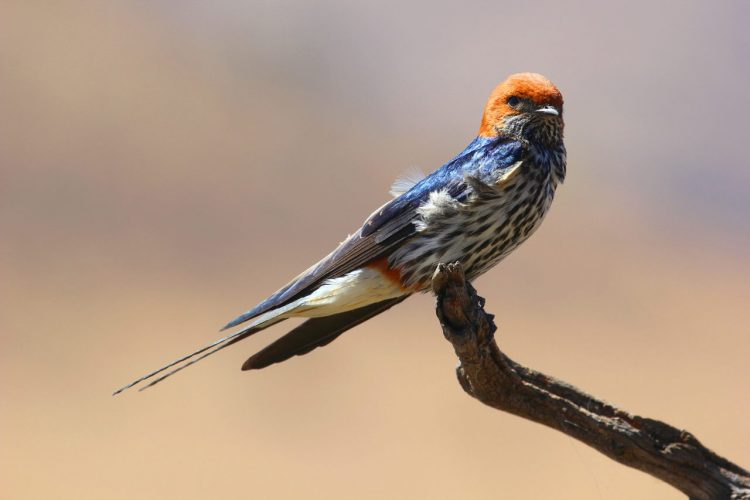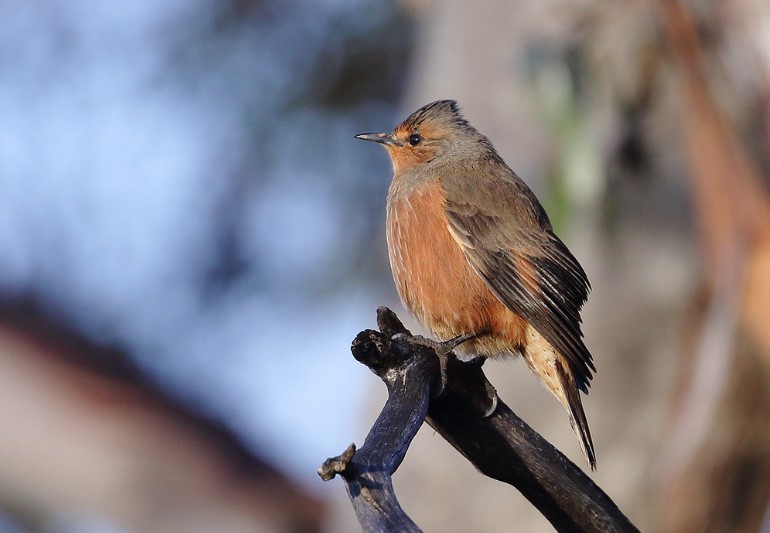Page Contents
Description:
Lesser Striped Swallow (Cecropis abyssinica) is a common species, which is distributed along the coast and adjacent interior of the Eastern Cape Province and Transkei, throughout much of KwaZulu-Natal, the Transvaal woodland areas, and most of Swaziland and Zimbabwe. In Botswana, it occurs in the east and commonly in the Okavango, and in Namibia, it is found along the Kunene and Kavango rivers, the Caprivi Strip, and scattered records further south.
This is one of the most abundant African swallows. It ranges over the greater part of Africa south of the Sahara, except for the open regions in the south and southwest. It is frequently confused with the similar Greater Striped Swallow, “H. cucullate,” in southern Africa.
Habitat:
It occurs in a variety of woodland and savanna habitats, but especially in semi-arid Kalahari savannas. Within these regions, it can also be found in cultivated and sub-urban areas. Also, it is more common in lower-lying than higher-lying areas within its range. It is recognized to nest frequently on riverbanks and trees. The bird’s flight is normally very strong, but can be very fast, like that of a Barn Swallow.

Movements:
This species shows complex patterns of movement in the region. It is largely a summer-breeding migrant in South Africa, but some birds are present throughout the year. Especially in the lower-lying eastern areas along the KwaZulu-Natal coast and in the Lowveld of the Transvaal and Swaziland. A winter exodus is also apparent in Zimbabwe. But the presence of birds in this country during the winter is more frequent than in most of South Africa, and birds from the south may pass through or winter in Zimbabwe.
The Zimbabwean breeding population leaves that country and is replaced by South African migrants during the winter. Hence, mainly from March to October, but the passage of the southern race unitatis through this area is likely from August to September and March to April.
The models for Zones 5 to 8 suggest reduced overwintering, and later arrival and departure times with increasing latitude for unitatis. Their breeding grounds are spread over several weeks and are probably influenced by the stage of individual breeding.
Also, the populations start to weaken as early as February and March in most regions. Some nests in the northern Kruger National Park were occupied throughout the year but different individuals used the nests during the summer and winter months, indicating that ‘residency’ does not necessarily involve the same individuals.

Breeding:
A summer-breeding pattern is shown by the race unitatis in the Eastern Cape Province (Zone 8), KwaZulu-Natal (Zone 7), and Transvaal (Zone 6), with the most breeding, recorded in August-May and peaking in November–December. Breeding starts earlier in the Transvaal than in the Eastern Cape Province.
In Zimbabwe breeding occurs throughout the year, but this contains records of unitatis on the plateau and “ampliformis” in the west, and most records refer to unitatis, whose breeding peaks in August–December. In Namibia and northern Botswana, breeding was recorded from March to October for “ampliformis,” indicating peak egg-laying for this race in May.
Interspecific Relationships:
This little bird often occurs alongside the Greater Striped Swallow, but typically, one species tends to be much more common than the other in areas of overlap. Because both species use man-made structures for breeding, they may compete for nest sites, and the smaller Lesser Striped Swallow may be at a disadvantage in such situations.
There could also be competition with the much larger Red-breasted Swallow (H. semirufa) for nest sites, but that species usually nests in more constricted sites than the two striped swallows. White-rumped Swifts (Apuscaffer) usurp the nests of Lesser Striped Swallows.
Historical distribution and conservation:
Like many Hirundinidae, this species has benefited from nesting in manmade structures and has probably increased, at least in density, in many areas owing to this habit. Moreover, here you can listen to the call of lesser-striped Swallow.
Nesting
Lesser Striped Swallow has a soft-lining nest, built in a cave or under a rock overhang or a tree branch. However, given the selections, it can opt to make a nest in high places. This little bird is willing to use buildings, bridges, culverts, and similar structures.
Description
Lesser Striped Swallow is 10 to 14cm long, with dark blue upperparts with a vibrant red rump and a rufous-chestnut crown nape and sides of the bird’s head. The white and dark streaking showing at the underparts is white; the tawny underwing flight feathers and upper wings are blackish brown. The long, beautiful blackish tail is normally longer in males than in females. However, the young one is a bit browner and duller, with less contrast.
Diet and Foraging
Lesser Striped swallow diet normally consist of bees, flying ants, beetles, flies, lepidopterans, fruits, and seeds. It feeds alone or in pairs, and also, mixes with other swifts. The bird habitually forages six- meters above ground, eight to 22 meters over treetops and often over the water. Hence, the birds also hover over vegetation to catch caterpillars and feed around different animals to catch insects and perches when eating fruit.
Read More: The white-throated magpie-jay






